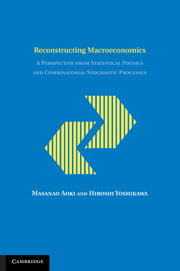 Reconstructing Macroeconomics
Reconstructing Macroeconomics Published online by Cambridge University Press: 08 August 2009
In the last ten years or so, I have devoted my research efforts to revising the commonly adopted frameworks for modeling and analysis by mainstream macroeconomists. Results of my initial thoughts and proposals were published in 1996, followed by another book in 2002. In these two books I explained my proposed methods for modeling and analyzing stochastic dynamic interactions among economic agents of possibly many different types, and how to analyze aggregate behavior and associated fluctuations. The two books are mostly exposition of concepts and techniques and had only a few suggestive economic examples.
I have realized that more substantive examples are needed to convince mainstream macroeconomists of the usefulness of my approaches. This book, jointly written with Hiroshi Yoshikawa, integrates the methodologies and approaches in these two earlier books with much more detailed analysis of more substantive and substantial macroeconomic examples.
As the subtitle of the book makes clear, our approaches have two components: (1) continuous-time Markov chains to model stochastic dynamic interactions among agents and (2) combinations of stochastic processes and non-classical combinatorial analysis, called combinatorial stochastic processes.
In (1) a version of Chapman–Kolmogorov equations called master equations describes how states of the models evolve stochastically over time. In this sense this part is devoted to applications of some of the concepts and methods from statistical physics.
To save this book to your Kindle, first ensure no-reply@cambridge.org is added to your Approved Personal Document E-mail List under your Personal Document Settings on the Manage Your Content and Devices page of your Amazon account. Then enter the ‘name’ part of your Kindle email address below. Find out more about saving to your Kindle.
Note you can select to save to either the @free.kindle.com or @kindle.com variations. ‘@free.kindle.com’ emails are free but can only be saved to your device when it is connected to wi-fi. ‘@kindle.com’ emails can be delivered even when you are not connected to wi-fi, but note that service fees apply.
Find out more about the Kindle Personal Document Service.
To save content items to your account, please confirm that you agree to abide by our usage policies. If this is the first time you use this feature, you will be asked to authorise Cambridge Core to connect with your account. Find out more about saving content to Dropbox.
To save content items to your account, please confirm that you agree to abide by our usage policies. If this is the first time you use this feature, you will be asked to authorise Cambridge Core to connect with your account. Find out more about saving content to Google Drive.